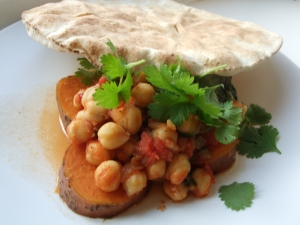Gastrogeek wrote about these meatballs quite recently, but I think they’re so good they deserve another write-up. It’s a sign of how truly great this cookbook is that in the past week this is the third thing that I’ve made for the second time – I still have many little post-it tags sticking to the pages of things I desperately want to make, but having tasted something as sublime as these meatballs you only want to make them again.
I think almost everyone likes meatballs and I’m no exception. Turkey is a bit unusual, but it makes them amazingly light, almost bouncy. The sweetcorn is lightly pan-fried before it goes in so it tastes more, well, sweetcorn-y, and there’s a gentle hint of cumin for spice. The roasted pepper sauce has a bit of a kick and really goes perfectly – I also cheated this time around and used a jar of roasted red peppers, which was a fine short cut.
Turkey and sweetcorn meatballs with roasted pepper sauce Serves 4
100g sweetcorn (fresh or frozen)
3 slices of stale white bread, crusts removed (you can use wholemeal, it works fine)
500g minced turkey
1 free-range egg
4 spring onions, finely chopped
2 tbsp finely chopped parsley (I left this out this time as I didn’t have any)
2 1/2 tsp ground cumin
1 1/2 tsp salt
1/2 tsp black pepper
1 garlic clove, crushed
sunflower oil or rapeseed oil for frying
For the roasted pepper sauce:
4 red peppers, or a small jar (200g) ready roasted peppers
1 – 3 tbsp olive oil (depending on whether your peppers need roasting)
1/2 – 1 tsp salt (depending on whether your peppers need roasting)
25g coriander, leaves and stalks
1 garlic clove, peeled
1 chilli, deseeded
2 tbsp sweet chilli sauce
2 tbsp cider vinegar or white wine vinegar
Preheat the oven to 200c. Start by making the sauce: if you’re using raw peppers, you’ll need to quarter and deseed them and roast them in the preheated oven for around 35 minutes with 2 tbsp of the olive oil and 1/2 tsp of the salt. You can peel them when they’ve cooled, but it’s not essential.
Place your peppers in a food processor or blender with 1 tbsp olive oil and 1/2 tsp salt, plus the rest of the sauce ingredients. Blend until smooth, then taste and adjust the seasoning if necessary.
For the meatballs, toss the sweetcorn in a hot pan for a few minutes until the kernels start to brown, then remove from the heat. Soak the bread in a little cold water for a minute, then squeeze well and crumble into a large mixing bowl (I should warn you, this is revolting). Add the rest of the meatball ingredients (except for the oil) and mix well with your hands.
Heat a couple of tablespoons of oil in a large frying pan. You can test the seasoning of the meatballs by frying a small amount of the mixture and tasting it. Shape the mince mixture into golf balls and cook in batches in the hot oil, turning, until golden brown all over, a couple of minutes on each side. Transfer to an oven tray (or you can just put the frying pan in the oven if it won’t melt) and bake in the 200c oven for 5-10 minutes until cooked through. Serve hot or warm with the pepper sauce.
From Yotam Ottolenghi and Sami Tamimi’s ‘Ottolenghi’.





